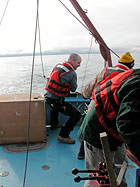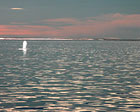

 | |||||||||||||
|
|
Journals 2006/2007Kirk Beckendorf
August 29, 2006 I just completed my first day of actually being out on the open ocean above Barrow. It was definitely an exciting day. Sunday we were just in the shallow lagoon. After an early breakfast we loaded our gear into the dual cab pickup and the six of us drove the 4 miles to the end of gravel road to where the Annika Marie is anchored. Mike ferries us from shore in a tiny motorized raft.
After lowering a couple of instruments into the water they are towed northward along a predetermined line for 20-25 miles. The two instruments constantly send information about the seawater to laptop computers on board. I'll tell you more about that in the next few days. At the end of our line we pulled the instruments out of the water and retraced our route. Retracing our route we stopped every few miles to collect more detailed data and towed the plankton nets.
On the outbound trip my job was to sit in the bridge and watch for and record sightings of birds and marine mammals. We saw a number of terns, gulls, phalaropes and other birds. Then we started seeing seals. Some were close to the boat; their grey heads about the size of a volleyball bobbing up and down like a fishing cork on a pond. But then I kept seeing something off in the distance, through my binoculars that seemed out of the ordinary. I said I was sure I had seen a whale nobody else saw it so I don't think anyone actually believed me. But then it was very obvious when, even with out binoculars, we could see water shooting up into the air. Soon we could see the backs of at least three whales. Even though they were a long way off it was obvious that they were huge. We are not sure what kind of whales they were, but they would have been either bowheads or gray whales. They are the first whales these researchers have seen this year.
Question of the day: Why would the scientists be interested in observing and recording the location and types of birds we see? |
||||||||||||


